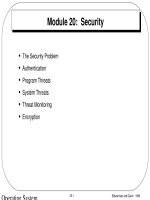Lecture Operating system concepts - Module 7
Bạn đang xem bản rút gọn của tài liệu. Xem và tải ngay bản đầy đủ của tài liệu tại đây (343.02 KB, 40 trang )
Module 7: Deadlocks
•
•
•
•
•
•
•
•
System Model
Deadlock Characterization
Methods for Handling Deadlocks
Deadlock Prevention
Deadlock Avoidance
Deadlock Detection
Recovery from Deadlock
Combined Approach to Deadlock Handling
7.1
Silberschatz and Galvin 1999
The Deadlock Problem
•
A set of blocked processes each holding a resource and waiting
to acquire a resource held by another process in the set.
•
Example
– System has 2 tape drives.
– P1 and P2 each hold one tape drive and each needs another
one.
•
Example
– semaphores A and B, initialized to 1
P0
P1
wait (A);
wait (B);
wait(B)
wait(A)
7.2
Silberschatz and Galvin 1999
Bridge Crossing Example
•
•
•
Traffic only in one direction.
•
•
Several cars may have to be backed upif a deadlock occurs.
Each section of a bridge can be viewed as a resource.
If a deadlock occurs, it can be resolved if one car backs up
(preempt resources and rollback).
Starvation is possible.
7.3
Silberschatz and Galvin 1999
System Model
•
Resource types R1, R2, . . ., Rm
CPU cycles, memory space, I/O devices
•
•
Each resource type Ri has Wi instances.
Each process utilizes a resource as follows:
– request
– use
– release
7.4
Silberschatz and Galvin 1999
Deadlock Characterization
Deadlock can arise if four conditions hold simultaneously.
•
Mutual exclusion: only one process at a time can use a
resource.
•
Hold and wait: a process holding at least one resource is
waiting to acquire additional resources held by other processes.
•
No preemption: a resource can be released only voluntarily by
the process holding it, after that process has completed its task.
•
Circular wait: there exists a set {P0, P1, …, P0} of waiting
processes such that P0 is waiting for a resource that is held by
P1, P1 is waiting for a resource that is held by P2, …, Pn–1 is
waiting for a resource that is held by Pn, and P0 is waiting for a
resource that is held by P0.
7.5
Silberschatz and Galvin 1999
Resource-Allocation Graph
A set of vertices V and a set of edges E.
•
V is partitioned into two types:
– P = {P1, P2, …, Pn}, the set consisting of all the processes in
the system.
– R = {R1, R2, …, Rm}, the set consisting of all resource types
in the system.
•
•
request edge – directed edge P1
Rj
assignment edge – directed edge Rj
7.6
Pi
Silberschatz and Galvin 1999
Resource-Allocation Graph (Cont.)
•
Process
•
Resource Type with 4 instances
•
Pi requests instance of Rj
Pi
Rj
•
Pi is holding an instance of Rj
Pi
Rj
7.7
Silberschatz and Galvin 1999
Example of a Resource Allocation Graph
7.8
Silberschatz and Galvin 1999
Resource Allocation Graph With A Deadlock
7.9
Silberschatz and Galvin 1999
Resource Allocation Graph With A Cycle But No Deadlock
7.10
Silberschatz and Galvin 1999
Basic Facts
•
•
If graph contains no cycles
no deadlock.
If graph contains a cycle
– if only one instance per resource type, then deadlock.
– if several instances per resource type, possibility of
deadlock.
7.11
Silberschatz and Galvin 1999
Methods for Handling Deadlocks
•
•
•
Ensure that the system will never enter a deadlock state.
Allow the system to enter a deadlock state and then recover.
Ignore the problem and pretend that deadlocks never occur in the
system; used by most operating systems, including UNIX.
7.12
Silberschatz and Galvin 1999
Deadlock Prevention
Restrain the ways request can be made.
•
Mutual Exclusion – not required for sharable resources; must
hold for nonsharable resources.
•
Hold and Wait – must guarantee that whenever a process
requests a resource, it does not hold any other resources.
– Require process to request and be allocated all its
resources before it begins execution, or allow process to
request resources only when the process has none.
– Low resource utilization; starvation possible.
7.13
Silberschatz and Galvin 1999
Deadlock Prevention (Cont.)
•
No Preemption –
– If a process that is holding some resources requests
another resource that cannot be immediately allocated to it,
then all resources currently being held are released.
– Preempted resources are added to the list of resources for
which the process is waiting.
– Process will be restarted only when it can regain its old
resources, as well as the new ones that it is requesting.
•
Circular Wait – impose a total ordering of all resource types, and
require that each process requests resources in an increasing
order of enumeration.
7.14
Silberschatz and Galvin 1999
Deadlock Avoidance
Requires that the system has some additional a priori information
available.
•
Simplest and most useful model requires that each process
declare the maximum number of resources of each type that it
may need.
•
The deadlock-avoidance algorithm dynamically examines the
resource-allocation state to ensure that there can never be a
circular-wait condition.
•
Resource-allocation state is defined by the number of available
and allocated resources, and the maximum demands of the
processes.
7.15
Silberschatz and Galvin 1999
Safe State
•
When a process requests an available resource, system must
decide if immediate allocation leaves the system in a safe state.
•
System is in safe state if there exists a safe sequence of all
processes.
•
Sequence <P1, P2, …, Pn> is safe if for each Pi, the resources
that Pi can still request can be satisfied by currently available
resources + resources held by all the Pj, with j
can wait until all Pj have finished.
– When Pj is finished, Pi can obtain needed resources,
execute, return allocated resources, and terminate.
– When Pi terminates, Pi+1 can obtain its needed resources,
and so on.
7.16
Silberschatz and Galvin 1999
Basic Facts
•
•
•
If a system is in safe state
If a system is in unsafe state
Avoidance
state.
no deadlocks.
possibility of deadlock.
ensure that a system will never enter an unsafe
7.17
Silberschatz and Galvin 1999
Safe, unsafe , deadlock state spaces
7.18
Silberschatz and Galvin 1999
Resource-Allocation Graph Algorithm
•
Claim edge Pi Rj indicated that process Pj may request
resource Rj; represented by a dashed line.
•
Claim edge converts to request edge when a process requests a
resource.
•
When a resource is released by a process, assignment edge
reconverts to a claim edge.
•
Resources must be claimed a priori in the system.
7.19
Silberschatz and Galvin 1999
Resource-Allocation Graph For Deadlock Avoidance
7.20
Silberschatz and Galvin 1999
Unsafe State In A Resource-Allocation Graph
7.21
Silberschatz and Galvin 1999
Banker’s Algorithm
•
•
•
•
Multiple instances.
Each process must a priori claim maximum use.
When a process requests a resource it may have to wait.
When a process gets all its resources it must return them in a
finite amount of time.
7.22
Silberschatz and Galvin 1999
Data Structures for the Banker’s Algorithm
Let n = number of processes, and m = number of resources types.
•
Available: Vector of length m. If available [j] = k, there are k
instances of resource type Rj available.
•
Max: n x m matrix. If Max [i,j] = k, then process Pi may request at
most k instances of resource type Rj.
•
Allocation: n x m matrix. If Allocation[i,j] = k then Pi is currently
allocated k instances of Rj.
•
Need: n x m matrix. If Need[i,j] = k, then Pi may need k more
instances of Rj to complete its task.
Need [i,j] = Max[i,j] – Allocation [i,j].
7.23
Silberschatz and Galvin 1999
Safety Algorithm
1. Let Work and Finish be vectors of length m and n, respectively.
Initialize:
Work := Available
Finish [i] = false for i - 1,3, …, n.
2. Find and i such that both:
(a) Finish [i] = false
(b) Needi Work
If no such i exists, go to step 4.
3. Work := Work + Allocationi
Finish[i] := true
go to step 2.
4. If Finish [i] = true for all i, then the system is in a safe state.
7.24
Silberschatz and Galvin 1999
Resource-Request Algorithm for Process Pi
Requesti = request vector for process Pi. If Requesti [j] = k then
process Pi wants k instances of resource type Rj.
1. If Requesti Needi go to step 2. Otherwise, raise error
condition, since process has exceeded its maximum claim.
2. If Requesti Available, go to step 3. Otherwise Pi must
wait, since resources are not available.
3. Pretend to allocate requested resources to Pi by modifying
the state as follows:
Available := Available = Requesti;
Allocationi := Allocationi + Requesti;
Needi := Needi – Requesti;;
• If safe
the resources are allocated to Pi.
• If unsafe
Pi must wait, and the old resource-allocation
state is restored
7.25
Silberschatz and Galvin 1999









